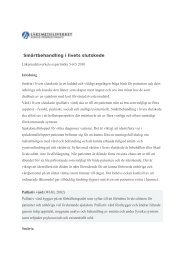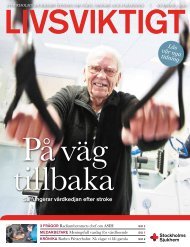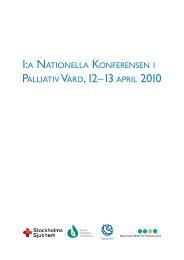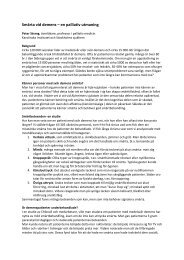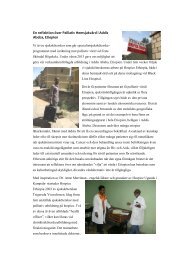Physiotherapy in palliative careâ - Stockholms sjukhem
Physiotherapy in palliative careâ - Stockholms sjukhem
Physiotherapy in palliative careâ - Stockholms sjukhem
You also want an ePaper? Increase the reach of your titles
YUMPU automatically turns print PDFs into web optimized ePapers that Google loves.
extremities up over the torso to the arm pits. Patients can have the feel<strong>in</strong>g that the edema causesheav<strong>in</strong>ess and a tension as well as a feel<strong>in</strong>g of weight<strong>in</strong>ess. Many become disabled as a result ofthe edemas.Lymphatic edemas are caused by the lack of transport capacity <strong>in</strong> the lymphatic system. It canoccur after <strong>in</strong> a grow<strong>in</strong>g tumor, after surgery or radiation, after <strong>in</strong>fection or be congenital.Lymphatic edemas most frequently occur <strong>in</strong> arms and legs but can also occur <strong>in</strong> the torso, headand neck area and <strong>in</strong> genitals which very often is experienced as very <strong>in</strong>tricate.For patients <strong>in</strong> a late <strong>palliative</strong> stage of disease medication with corticosteroids is quitecommon. Corticosteroids make the sk<strong>in</strong> become very frail which <strong>in</strong>creases the risk of sk<strong>in</strong><strong>in</strong>fections like erysipelas that can be treated with antibiotics. Wounds or lymphatic fistulas<strong>in</strong>crease the risk for leakage of liquid through the sk<strong>in</strong>, so called lymphatic leakage. (7, 36, 37,38) Good sk<strong>in</strong> care like us<strong>in</strong>g a soften<strong>in</strong>g sk<strong>in</strong> lotion can prevent wounds and reduce the risk ofsk<strong>in</strong> <strong>in</strong>fections.Assessment:Differential diagnosis is made together with a physician to diagnose or exclude thrombosisand/or suspected erysipelas.How did the swell<strong>in</strong>g start and where is it situated and does it change dur<strong>in</strong>g the day?How does the sk<strong>in</strong> look?If some other parts of the body rather than feet and legs are swollen and if you feel uncerta<strong>in</strong> asto how the patient is best treated - consult a lymphatic therapist.Treatment:The most common treatment for at patient <strong>in</strong> a late stage of <strong>palliative</strong> disease with swollen legsis to try out compression stock<strong>in</strong>gs <strong>in</strong> compression class1, so called anti thrombosis stock<strong>in</strong>gs.If the sk<strong>in</strong> is fragile the extremity should be bandaged. The expected effect of the treatment is toreduce the volume of the edema, improve the status of the sk<strong>in</strong> and to stop the leakage of thelymphatic liquid and improve function. (7, 36) Make sure that the edema does not move fromthe leg to the abdomen or to the genitals. When the patient is <strong>in</strong> a late <strong>palliative</strong> stage of thedisease, make an assessment of the effect of improved function and reduced unpleasantness aswell as that the treatment does not h<strong>in</strong>der the patients daily activities.Comb<strong>in</strong>ed Decongestive Therapy – CDT is an established treatment method used <strong>in</strong> Swedenand <strong>in</strong>ternationally and is carried out by lymphatic therapists. The therapy consists of<strong>Physiotherapy</strong> <strong>in</strong> <strong>palliative</strong> care – a cl<strong>in</strong>ical handbook Ulla Frymark, Lilian Hallgren, Ann‐Charlotte Reisberg 25







